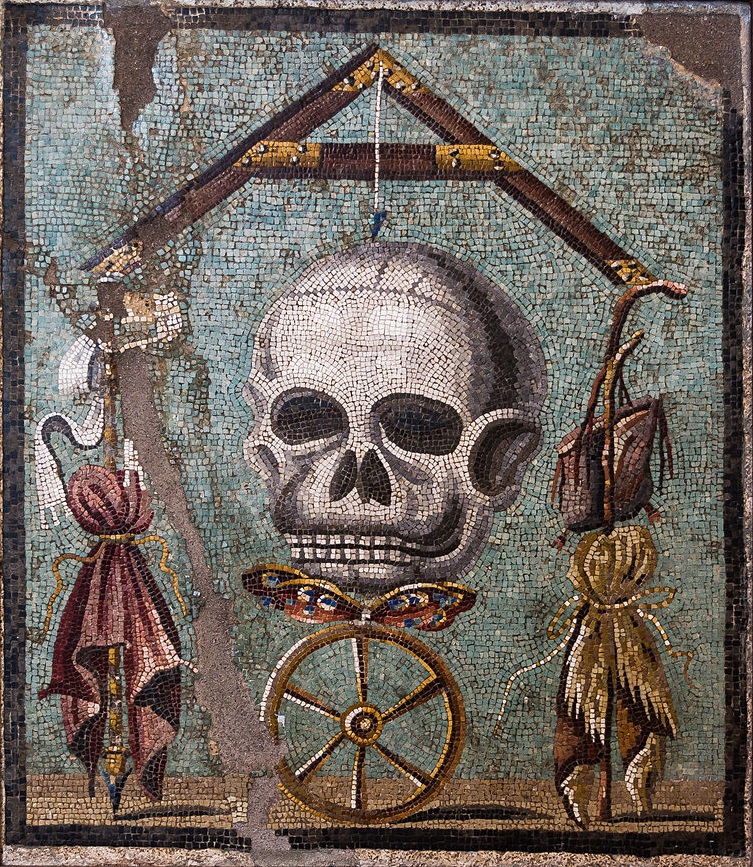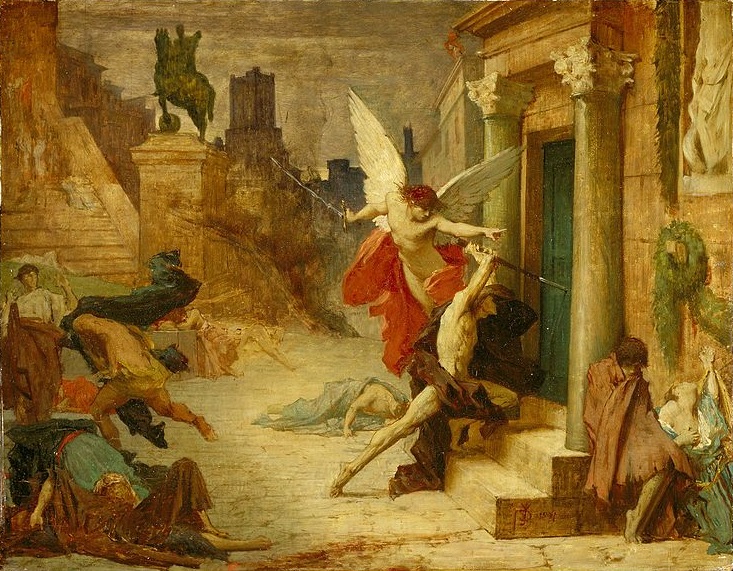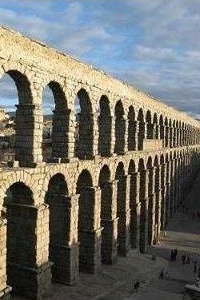Diseases and pandemics in Ancient Rome
Published on 29 October 2020Reading time: 15 minutes
The study of diseases and pandemics in Ancient Rome starts with understanding Roman society and Roman customs. The Romans had access to doctors and placed a lot of importance on cleanliness and bathing. Nevertheless, diseases were prevalent in the ancient world, and the Romans went through several pandemics that took the lives of millions. Several factors contributed to the spread of diseases, including the expansion of the Roman Empire and trade, urbanization, and deforestation. Surprisingly, Roman plagues and their causes have a lot in common with the pandemics of today.
Common diseases in Ancient Rome
Several diseases were common in Ancient Rome. Many Romans had dental problems, and if you walked around the city of Rome 2,000 years ago, you would come across many people with bad or rotten teeth. One reason for the bad teeth was the Roman bread, which wore down people's teeth as it was often coarse and contained bits of grain. Like the Egyptians or the Greeks, the Romans brushed their teeth using toothbrushes made from twigs. Doctors also knew about the importance of brushing teeth: in De Medicina, Aulus Cornelius Celsus1 (25 BC – 50 AD) mentions that food leftovers cause a disease called caries dentium. But it was mostly the upper class who would take great care of their teeth and who appreciated white teeth. Wealthy Romans even had slaves who would do the brushing for them using toothbrushes and applying various polishing powders such as charcoal.
 Roman mosaic of the 1st century BC representing the Wheel of Fortune which, as it turns, can make the rich (symbolized by the purple cloth on the left) poor and the poor (symbolized by the goatskin at right) rich; in effect both states are very precarious, with death never far and life hanging by a thread: when it breaks, the soul (symbolized by the butterfly) flies off. And thus are all made equal. Public domain |
A prevalent disease in Ancient Rome was malaria. We know that from the DNA analysis of the bones of ancient Romans. Malaria still exists today, especially in the Third World, and is usually transmitted by mosquitoes. Symptoms include shaking chills, muscle aches, headaches, and tiredness, and the disease can lead to mental confusion, seizures, kidney failure, coma, and death. There were also several life-threatening respiratory diseases such as tuberculosis and brucellosis. Tuberculosis was a common disease in the ancient world, and it still exists today. It is a contagious infection that usually attacks the lungs and can also spread to other parts of the body, like the brain and spine. The Greeks called it phthisis to describe a feeling of intense heat as if being burned by a flame. Brucellosis was prevalent in Ancient Rome, even though it is not as common today. It is usually contracted from dairy products or contaminated meat and begins with a fever and sweating, joint pain, and body aches, and can end with organ failure.
Other diseases common today, such as cancer and diabetes, were not as common in Ancient Rome. The Greeks and the Romans recognized cancer but had little understanding of it. Hippocrates (410 - 360 BC) described cancer (carcinos) as having a range of tumors and swelling that could spread to other parts of the body. The Romans knew about diabetes. Galenus describes the disease in his book in great detail but noted that he had only ever seen two people with this disease in his entire life, which suggests that it was relatively rare in those days. The absence of air pollution and most of all, the diet, and the fact that Romans ate smaller quantities and did not eat processed foods or as much meat as we do today, probably explains the rarity of cancer and diabetes back then.
Closely linked to slavery, prostitution was rampant in Rome and facilitated the spread of sexually transmitted diseases. Recent studies have shown that syphilis was prevalent in the ancient world and is not an STD that came from the Americas to Europe in the late 1400s. Palladius describes the disease in the Lausiac History 262, and French researchers from the CNRS have said that it was not leprosy described in the book, but in fact, venereal syphilis. Analysis of bones by researchers in Pompei and France have revealed that people died from syphilis. Unlike syphilis, gonorrhea does not leave decisive skeletal traces. But, along with many other STDs, it probably existed in Ancient Rome.
Roman plagues and pandemics
Ancient Rome went through several pandemics, by chronological order: the Antonine Plague (165 - 180 AD), The Plague of Cyprian (249 - 262 AD), The Plague of Justinian (541 - 542 AD), The Roman Plague (590 AD).The Antonine Plague (165 - 180 AD), a.k.a the Plague of Galen (or Galenus) from the Greek physician's name, provided a detailed account of the disease. It was an ancient pandemic brought to the Roman Empire by soldiers returning from campaigns in the Near East (modern-day Iraq). In the treatise Methodus Medendi, Galenus describes the pandemic as affecting many people and lasting for a long time (15 years!). Based on Galenus' account, the disease's terrifying symptoms were at the onset a fever, a sore throat, and diarrhea. By the ninth day, the condition evolved to blisters of pus (pustular psoriasis) surrounded by red skin. Modern scholars generally diagnose the disease like smallpox. According to historian Dio Cassius3 (155 – 235 AD), the Antonine Plague caused up to 2,000 deaths per day in Rome and had a mortality rate of 25%. The plague spread throughout the Roman Empire, killing five million people, and may have even reached China in 166 AD. It also probably killed Roman co-Emperor Lucius Verus who ruled the empire with Marcus Aurelius Antoninus during the Roman Principate hence the name "Antonine" Plague. Historians also believe that the plague fueled the growing popularity of Christianity.
The Plague of Cyprian (249 - 262 AD), named after an early Christian writer called St Cyprian4, bishop of Carthage, who described the pandemic in his book De mortalitate. St Cyprian described the symptoms as follows: constant vomiting, diarrhea, red eyes, limping, gradual loss of sight and hearing, decaying feet, or limbs. At the height of the outbreak, 5,000 people a day were reportedly dying from the disease in Rome. The pandemic was so severe that it created labor shortages, which affected food production, and wreaked havoc in the army. Historians are not sure what the disease was but suspect that it could have been smallpox, pandemic influenza such as swine flu, or even a filovirus such as the Ebola virus.
 The Plague in Rome, Jules Elie Delaunay (1869) Public domain |
The Plague of Justinian (541 - 542 AD) was one of the deadliest, if not the deadliest pandemic in human history. It lasted two years but with recurrences until 750 AD and resulted in the deaths of an estimated 25 to 100 million people. Emperor Justinian himself contracted the disease but managed to survive it. The disease affected mainly Constantinople, the Sasanian Empire and port cities in the Mediterranean as merchant ships harbored rats that carried fleas infected with plague. At its peak the pandemic killed an estimated 5,000 people per day in Constantinople. Dead bodies littered the streets of the capital and burial pits were dug by soldiers to handle the large number of deceased people. Animals of all types, including cats and dogs, could be seen lying dead throughout the city. In 2013, researchers confirmed the identity of the plague as yersinia pestis, a bubonic plague which was later responsible for the Black Death of 1347 – 1351 AD. The symptoms of the Plague of Justinian were terrifying and included chills, headaches, abdominal pain, swollen lymph nodes and gangrene.
The Roman Plague (590 AD) mainly affected the city of Rome. The epidemic killed a large number of people in the city with many dying shortly after contracting the disease.
The causes of Roman pandemics and diseases
The causes of Roman pandemics have a lot in common with those of modern pandemics. It is maybe no coincidence that all of the Roman plagues took place during the Roman Empire when cities became bigger, when a network of Roman roads stretched from northern England to southern Egypt, when Romans started cutting entire forests. The causes of Roman pandemics included lack of hygiene, malnutrition, urbanization, deforestation and globalization.Hygiene in Roman society
The Romans grasped the connection between health and hygiene (from Greek hygeia meaning health). They even thought that, to keep the population healthy, hygiene and easy access to water were more important than medicine. They built water systems and magnificent aqueducts that brought water from far-away sources or mountains to cities and towns. These aqueducts supplied water to fountains in the city center, Roman baths, to public toilets (also called latrines) and the homes of wealthy Romans. Average Romans would regularly visit the baths while wealthy Romans often had their own private bathing facilities in their villas.However, the standards of cleanliness were much lower than the standards that are generally accepted today. The Romans did not have chemicals such as chlorine to disinfect the heated water and bacteria often thrived at the public baths, sometimes causing disease. Also, the latrines, which used the sewer system and where people would sit right next to each other, could be quite filthy by modern standards. The use of such latrines probably contributed to spreading disease. Still, things would have been probably a lot worse without any form of public hygiene.
Malnutrition
The lifestyle of the average Roman was quite tough. Most Romans would wake up early in the morning, work hard and go to bed early as they could not afford lighting their oil lamps. The poorest Romans could also not afford a diversified diet. Their diet was limited to monthly rations of grain that they would use to make bread or puls, a pottage made of emmer, olive oil, salt, mixed with various herbs. The lack of a diversified diet probably contributed to multiple vitamin deficiencies, a weaker immune system and to making the poorest Romans more susceptible to viruses. As we previously mentioned, the Roman diet also had some positives: the Romans ate small quantities and they did not consume a lot of meat, as they could not afford it, and they ate mostly grain, fruits and vegetables. Therefore, problems such as obesity, and diseases such as diabetes and cancer were not as common.
Back then the food was not monitored by a food agency such as the Food and Drug Administration. As a result, the Romans were often exposed to food poisoning due to contamination with microbes and parasites. The presence of parasites in the food was often made worse by the use of human feces as fertilizer, something that is unthinkable today, thereby exposing the produce to human pathogens.
Moreover, the quality of the water supplied by the aqueducts could vary. Some were known to supply excellent quality water while others were less well-maintained or prone to muddy water, especially after heavy rain. Many of the water pipes were made of lead exposing the population to lead poisoning. However, it must be noted that even though the lead carried by the water in the aqueducts was 100 times higher than what is acceptable today, it wasn’t enough to cause lead poisoning as lead pipes built limescale over time, reducing the risk of poisoning. The real cause of lead poisoning was the use of pots made of lead for cooking or of lead powder in place of modern sugar, as the Romans appreciated the taste of lead.
Urbanization
The process of urbanization accelerated during the Roman Empire. In the cities, people from various backgrounds and from the four corners of the empire often lived in close proximity in overcrowded buildings called insulae. Streets tended to be dirty, even though laws required cities to remove waste from the streets, and during heavy rain storms the sewer system could overflow with human waste. Therefore, the process of urbanization contributed to the spread of disease and to the emergence of pandemics.Deforestation
The process of urbanization also led to the deforestation of cities and this often happened near rivers. Deforestation led to a rising water table and to the development of marshes where larvae, blood-sucking bugs and mosquitoes thrived. These larvae, bugs and mosquitoes were all carriers of various diseases such as malaria, which easily spread to the population in the cities. Interestingly, epidemiologists trace many modern pandemics such as the COVID-19 pandemic to deforestation. COVID-19 is believed to have zoonotic origins and according to epidemiologists deforestation, wildlife farming and trade in unsanitary conditions increases the risk of zoonotic diseases.Globalization
During the Roman Empire, Rome's territory stretched from the Hadrian Wall in northern england to Hierasycaminus (al-Maharraqah today) close to modern-day Luxor in southern Egypt. Rome's road network reached a total length of 74,500 miles (or 120,000 km). The Romans controlled the Mediterranean Sea ("mare nostrum") and trade was very developed with a large number of ships constantly sailing the commercial shipping lanes on more or less regular schedules and routes, bringing supplies from the provinces (e.g. Egypt, Gaul, Greece, etc) to the ports of the Italian peninsula. The extensive road network and the circulation of ships facilitated the spread of diseases. For example, during the Plague of Justinian (541 - 542 AD) the black rat, which traveled on grain ships, spread the plague from North Africa to a number of port cities including the city of Constantinople.Healthcare in Ancient Rome
Initially, the Romans placed little trust in doctors and mostly relied on religious rituals and an infrastructure that supplied large amounts of water to the population. The Romans used the baths also for the health benefits associated to their use. By the second century BC, the Romans had fully adopted ancient Greek medicine. A number of famous Greek physicians such as Galenus, Dioscorides or Soranus transmitted their knowledge in Rome. The first school of medicine in the ancient world was the Alexandria Shool of Medicine where physicians engaged in a four-year course of study. The education received was primarily centered on the teachings of Galenus (129-217 AD)5, which was based on the concept of humorism. Humorism was a medical system which treated diseases based upon bodily fluids, called "humors". Doctors believed that plagues caused specific imbalances in the body and then applied specific herbal remedies to treat these imbalances. For example, chamomile was used to decrease heat and lower excessive bile humor. Therefore, doctors treated the imbalance, but did not go after the disease per say, which goes to show how different their understanding of medicine was.
 Portrait of Galen, Georg Paul Busch (1756) CC 4.0 |
Not all doctors went to medical school or received training from well-known doctors. Wealthy Romans had access to the best doctors in Rome, which often were part of their household staff. Those doctors were usually Greek. For example, Galenus was the personal physician of several emperors including Emperor Commodus (reign: 161 –192 AD). Average Romans had access to public doctors whose reputation and competency could vary greatly. In Ancient Rome, there was no regulatory board or official licensing for physicians, and doctors were often illiterate. Back then, everything was based on the doctor's reputation and healing rate. Some doctors did a pretty decent job and provided effective treatments. Good doctors coud go private and charge a price for their treatments. However, there were also many doctors that would claim healing powers and scam the needy. Unfortunately, it can be said that many Romans did not have access to good healthcare and often resorted to unproven remedies and prayer to cure themselves.
Roman medicine was quite elaborate and, just like today, contained many branches. The Romans even practiced surgery and used surgical intruments, which were surprisingly similar to the ones used today to include tweezers, forceps, scalpels and catheters. The Romans did not have hospitals through and surgery would be practiced at the doctor's office or even at home. The only hospitals were military hospitals called valetudinarian where permanent physicians would be present and where surgery was extensively practiced. The Romans understood that being able to care for the wounded gave them an advantage on the battlefield. Just like today, military hospitals often provided the most advanced medical treatments and were the places where medical advances were made.
As we previously mentioned, Roman medicine was based on the concept of humors or the treatment of imbalances in bodily fluids by applying specific herbal remedies. For example, gentiana, named after the Illyrian king Gentius, who discovered the tonic properties of the plant, was used to treat fever, digestive problems, ulcers, poisonous bites, parasitic worms, and even malaria. Autumn crocus, which contains colchicine and morphine, was used to treat gout (podagra) and a number of other diseases. Chamomile was used to decrease heat and lower excessive bile. Aloe, still extensively used today, was used to heal wounds and to treat alopecia. The Romans had no knowledge of microbes or viruses but knew about contagion and understood the importance of sanitation to curb the spread of diseases. During the various plagues, they even practiced quarantine and restricted travel to and from certain regions. For example, during the Plague of Justinian, a law was enacted that banned or isolated people from plague-infested regions.
Conclusion
If a modern-day person could somehow be transported to the city of Rome 2,000 years ago, he or she would see a lot of people suffering from various illnesses, from dental diseases to horrific life-threatening respiratory diseases such as tuberculosis and brucellosis. Nevertheless, thanks to a developed water infrastructure and knowledge of the best medicine of their time, the Romans lived a healthier life than most people of their era. Still, only the wealthy, and maybe soldiers on the battlefield, had access to the best healthcare.
Interesting fact about Roman diseases and pandemics
|
SOURCES
YOU MAY ALSO LIKE
Return from Pandemics in Ancient Rome to Homepage


